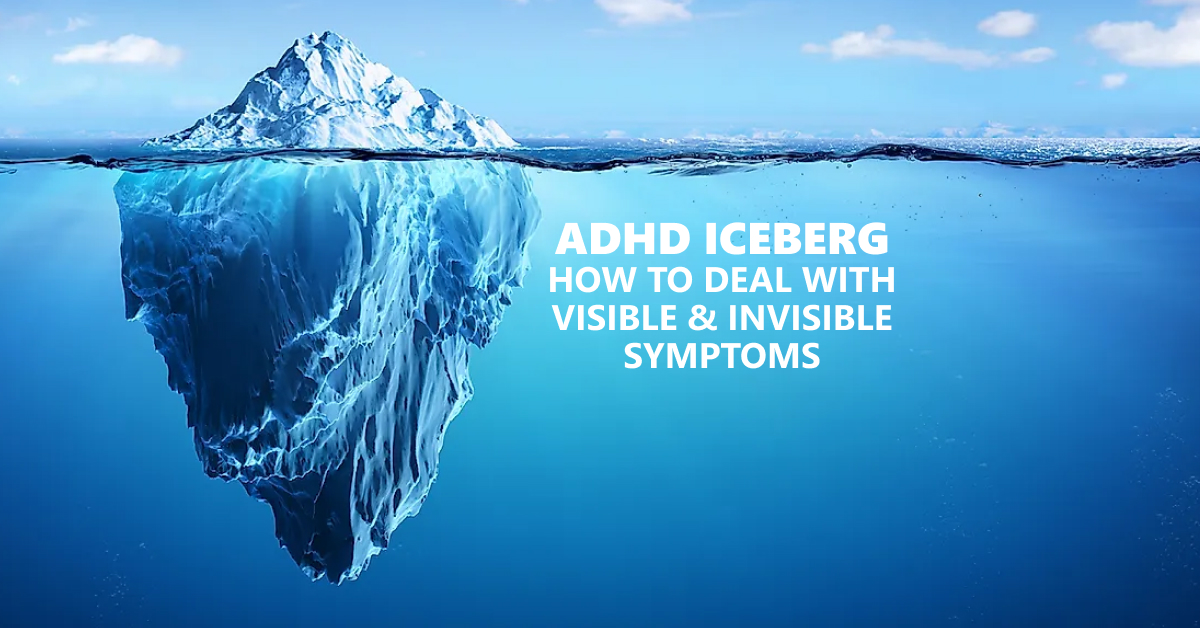What Does ADHD Stand For?
Attention Deficit Hyperactivity Disorder (ADHD) is a neurodevelopmental disorder that affects millions of people worldwide. It is characterized by difficulty paying attention, hyperactivity, and impulsiveness. ADHD has become increasingly more common in recent years. According to a 2019 report published by the Centers for Disease Control and Prevention, 6.1 million children in the US have been diagnosed with ADHD.
ADHD is generally divided into two types:
- inattentive
- hyperactive
An inattentive person has difficulty focusing on tasks and often has trouble completing them.Hyperactive type is when the person may be overly talkative or unable to sit still. Both types can cause difficulty in school, at work, or during social interactions. There are also many other invisible symptoms of ADHD that can be difficult to recognize, such as problems with short-term memory, processing speed and executive functioning skills.
What Does “ADHD Iceberg” Mean?
“ADHD iceberg” is a phrase used to describe the fact that although there are certain “visible” symptoms of Attention Deficit Hyperactivity Disorder, there may be other underlying issues that go unrecognized by society. This concept is often illustrated by an “ADHD iceberg graphic”, which shows the “tip of the iceberg” as being made up of the most common and well-known symptoms such as impulsivity or distractibility, while the “below-the-surface” issues include struggles with executive functioning, organization, planning and managing stress. Despite all this, an individual with ADHD can still lead a healthy and rewarding life with proper care and accommodations.
ADHD Iceberg: Visible Symptoms
Inattentive Symptoms of ADHD
- Easily distracted by irrelevant stimuli or outside activities.
- Difficulty sustaining attention during tasks or conversations.
- Forgetful in daily activities, such as forgetting to do chores or misplacing items.
- Poor organization skills, such as having trouble keeping track of appointments and losing track of time.
- Difficulty following instructions, especially those that require more than one step.
- Disorganized work habits, such as not completing assignments or projects on time, leaving projects unfinished or failing to meet deadlines.
- Struggles to pay attention when spoken to directly and may appear to be daydreaming instead of listening.
- Difficulty starting and finishing tasks independently without needing reminders from others and repeating mistakes due to lack of focus on the task at hand.
Hyperactive Symptoms of ADHD
- Fidgeting with hands or feet and squirming while seated in a chair.
- Constant talking, often talking without pause and interrupting conversations with others frequently.
- Difficulty playing quietly and waiting for their turn in a conversation, game or activity without becoming overly excited or speaking out inappropriately.
- Excessive running, climbing and other activities that are age inappropriate. Such behavior is also known as hyperactivity which can be disruptive even in adults despite being seen more commonly in children than adults with this condition.
- Trouble sitting still for extended periods of time and an inability to remain seated when expected to do so (e.g., school).
- Acting impulsively by blurting out answers before questions have been completed, interrupting others’ conversations, darting away from situations abruptly without explanation etc.
ADHD Iceberg: Invisible Symptoms
Impulsivity
People with ADHD may act without thinking, experiencing difficulty controlling their behavior and emotions. They tend to make decisions and take action quickly without considering the consequences of their choices and often engage in risky behaviors.
Hyperactivity
Individuals with ADHD may exhibit high levels of energy, restlessness, and lack of focus that can make it difficult to sit still or stay on task for extended periods of time. They may also fidget and talk excessively as part of an inability to control their impulses.
Inattention
Those with ADHD often have difficulty paying attention to details or staying on task for long periods at a time, easily becoming distracted by things around them. They may overlook important instructions or miss key points in conversations.
Poor Organization Skills
People with ADHD may struggle with organizing tasks and activities in order to complete them efficiently, leading to procrastination and disorganization which can further compound problems related to concentration and attention deficits.
Time Management Challenges
Difficulty managing time is a common symptom of ADHD, resulting in missed deadlines, lateness, and procrastination due to difficulty prioritizing tasks or activities as well as incomplete assignments when trying to multitask too many projects simultaneously.
Low Frustration Tolerance
Those living with ADHD can suffer from lower frustration tolerance than those without the condition, leading to outbursts when feeling overwhelmed or frustrated by a situation or task that seems overly difficult or challenging.
Disorganization
People with ADHD can be extremely disorganized due to impulsivity as well as difficulty concentrating on individual tasks for long periods at a time which can lead to clutter both physical and mental that can be hard to manage over time.
Social Challenges
Living with ADHD can come with its own set of social challenges such as difficulty understanding the thoughts or feelings of others due to impulsivity making it hard for individuals living with the condition interact appropriately in social situations causing them discomfort or embarrassment when misinterpreting cues from peers or adults they are interacting with socially.
What Makes ADHD Neurodivergent?
The term “neurodivergent” refers to any individual who experiences neurological differences from the majority of people around them. Are ADHD people neurodivergent? The answer is “yes”. People with ADHD are considered neurodivergent because their brains process information differently than those without it.
Neurodivergent symptoms are:
- being slower at understanding new concepts or tasks;
- struggling with following directions;
- having difficulty regulating their emotions;
- misunderstanding social cues more easily than others.
These differences can lead to feelings of frustration and helplessness for those living with ADHD, making it difficult for them to cope with life’s demands.
What are ADHD coping mechanisms?
There are several strategies that can help adults and children living with ADHD manage their symptoms better.
- One of the most important strategies is finding ways to focus on task completion rather than multitasking. This will help reduce stress levels as well as make it easier to accomplish goals on time.
- It is also important to create an environment that encourages productivity: eliminate distractions like phones or televisions while completing tasks;
- break down large goals into smaller milestones; use timers or reminders when necessary;
- take breaks often while working on something that requires sustained concentration;
- seek professional help if needed.
How do adults with ADHD cope?
In addition to these strategies, there are also specific coping mechanisms that adults living with ADHD can use when faced with difficult situations related to their diagnosis — such as:
- asking for help when needed;
- setting realistic expectations for themselves and others around them;
- taking deep breaths whenever anxiety arises;
- avoiding high-risk activities such as driving without medication/therapy/support if necessary;
- monitoring one’s own emotional state throughout the day so irrational thoughts don’t take over decisions made in haste.This steps might bring comfort and peace in stressful times.
Takeaways
Overall, living with ADHD can be a challenge but there are many ways adults (and children) living with this disorder can find relief from its symptoms both visible and invisible ones so they can lead healthy lives full of joy! By understanding what one’s triggers are and learning how to manage emotions effectively through mindfulness techniques, creating an optimal working environment, seeking professional help if needed, breaking down big tasks into smaller ones, focusing on task completion rather than multitasking, engaging in physical activity regularly, setting realistic expectations, taking deep breaths when anxious, avoiding high risk activities if not supported properly etc – one can find ways of managing both visible & invisible symptoms of ADHD successfully.


